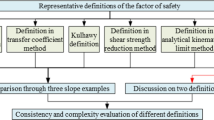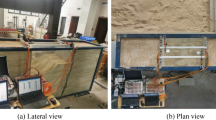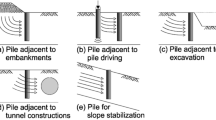Abstract
The work at hand deals with the design of the longitudinal spacing among rows of closely spaced large-diameter shafts used to stabilise a precarious slope. The problem under consideration is idealised through a conceptual framework where an unstable mass of an infinitely long slope pushes a stable portion of soil adjacent to shafts, leading to failure along a slip surface passing through the upper end of the reinforcement elements. By exploiting the upper bound theorem of plastic collapse, a closed-form solution is derived for the load required for the failure of the stable mass as a function of geometrical and mechanical parameters of the slope and the soil. Results are validated through physical model tests by means of geotechnical centrifuge. Given the satisfactory agreement between analytical and experimental results, the model is extended to evaluate the safety conditions of the reinforced slope.












Similar content being viewed by others
References
Atkinson J (1993) An introduction to the mechanics of soils and foundations: through critical state soil mechanics. McGraw-Hill Book Company (UK) Ltd, New York
Ausilio E, Conte E, Dente G (2001) Stability analysis of slopes reinforced with piles. Comput Geotech 28(8):591–611
Baguelin F, Frank R, Said YH (1977) Theoretical study of lateral reaction mechanism of piles. Géotechnique 27(3):405–434
Baldi G, Belloni G, Maggioni W (1988) The ISMES geotechnical centrifuge. In: Corté JF (ed) Centrifuge 88, Paris. Balkema, Rotterdam, pp 45–48
Bosscher PJ, Gray DH (1986) Soil arching in sandy slopes. J Geotech Eng 112(6):626–645
CEN (2004). Eurocode 7 Geotechnical design. Part 1: General rules. European Committee for Standardization, Brussels
Chen WF (1975) Limit analysis and soil plasticity. Elsevier, Amsterdam
De Beer EE, Carpentier R (1977) Discussion of the paper by Ito and Matsui (1975). Soils Found 16(1):68–82
Drescher A, Detournay E (1993) Limit load in translational failure mechanisms for associative and non-associative materials. Géotechnique 43(3):443–456
Fioravante V (2000) Anisotropy of small strain stiffness of Ticino and Kenya sands from seismic wave propagation measured in triaxial testing. Soils Found 40(4):129–142
Fioravante V (2008) Physical modelling of landslide stabilization methods in an overconsolidated clay. Geotech Test J 31(2):175–191
Guo WD (2013) Simple model for nonlinear response of 52 laterally loaded piles. J Geotech Geoenviron Eng ASCE 139:234–252
Hassiotis S, Chameau JL, Gunaratne M (1997) Design method for stabilization of slopes with piles. J Geotech Geoenviron Eng ASCE 123(4):314–323
Hull TS (1993) Analysis of the stability of slopes with piles. In: Proceedings of the 12th Asian Geotechnical Conference, Singapore, pp 639–643
Ito T, Matsui T (1975) Methods to estimate lateral force acting on stabilizing piles. Soils Found 15(4):43–59
Kourkoulis R, Gelagoti F, Anastasopoulos I, Gazetas G (2011) Slope stabilizing piles and pile-groups: parametric study and design insights. J Geotech Geoenviron Eng ASCE 137(7):663–678
Kourkoulis R, Gelagoti F, Anastasopoulos I, Gazetas G (2012) Hybrid method for analysis and design of slope stabilizing piles. J Geotech Geoenviron Eng ASCE 138(1):1–14
Michalowski RL (1995) Slope stability analysis-a kinematical approach. Géotechnique 45(2):283–293
Muir Wood D (2004) Geotechnical modelling. Spon Press, New York
Muraro S, Madaschi A, Gaio A (2014) On the reliability of 3D numerical analyses on passive piles used for slope stabilisation in frictional soils. Géotechnique 64(6):486–492
Oakland MW, Chameau JLA (1984) Finite element analysis of drilled piers used for slope stabilization. In: Langer JA, Mosley ET, Thompson CD (eds) Laterally loaded deep foundations: analysis and performance, ASTM STP 835, pp 182–193. West Conshohocken, PA, USA: ASTM
Poulos HG (1995) Design of reinforcing piles to increase slope stability. Can Geotech J 32:808–818
Schofield AN (1980) Cambridge geotechnical centrifuge operations. Géotechnique 30(3):227–268
Viggiani C (1981) Ultimate lateral load on piles used to stabilize landslides. In: Proceedings of the 10th international conference on soil mechanics and foundation engineering, vol 3. Stockholm, Sweden, pp 555–560
Zhang G, Wang LP (2016) Integrated analysis of a coupled mechanism for the failure processes of pile-reinforced slopes. Acta Geotech 11:941–952
Zhang G, Wang LP, Wang YL (2017) Pile reinforcement mechanism of soil slopes. Acta Geotech 12:1035–1046
Author information
Authors and Affiliations
Corresponding author
Appendix
Appendix
1.1 Derivation of Equation (4)
With reference to the triangle OCB (see Figs. 4 and 5), the law of sines assures that:
By making use of the law of cosines:
and therefore:
from which we obtain Eq. (4).
1.2 Derivation of Equation (11)
Solving Eq. (10) for \(\dot{Q}\) and dividing both sides of the equation by \(\dot{\omega }\,\gamma H^{2} \left( {r_{0} \cos \varphi - h} \right)\):
Multiplying both numerator and denominator of the right side of the above equation by (6/H3) one obtains Eq. (11).
Rights and permissions
About this article
Cite this article
Di Laora, R., Fioravante, V. A method for designing the longitudinal spacing of slope-stabilising shafts. Acta Geotech. 13, 1141–1153 (2018). https://doi.org/10.1007/s11440-017-0617-2
Received:
Accepted:
Published:
Issue Date:
DOI: https://doi.org/10.1007/s11440-017-0617-2




